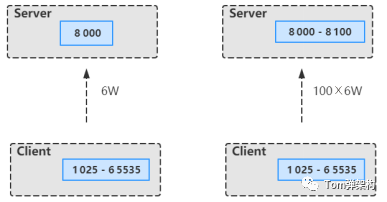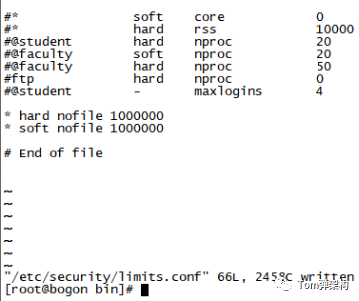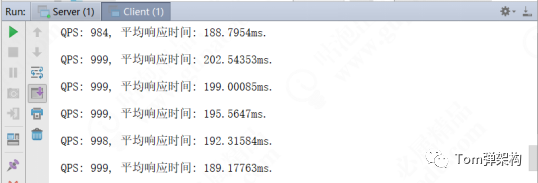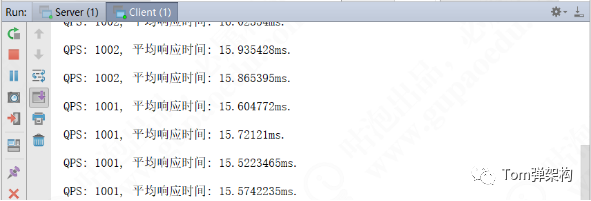1 模拟单机连接瓶颈
我们知道,通常启动一个服务端会绑定一个端口,例如8000端口,当然客户端连接端口是有限制的,除去最大端口65535和默认的1024端口及以下的端口,就只剩下1 024~65 535个,再扣除一些常用端口,实际可用端口只有6万个左右。那么,我们如何实现单机百万连接呢?假设在服务端启动[8 000,8 100)这100个端口,100×6万就可以实现600万左右的连接,这是TCP的一个基础知识,虽然对于客户端来说是同一个端口号,但是对于服务端来说是不同的端口号,由于TCP是一个私源组概念,也就是说它是由源IP地址、源端口号、目的IP地址和目的端口号确定的,当源IP地址和源端口号是一样的,但是目的端口号不一样,那么最终系统底层会把它当作两条TCP连接来处理,所以这里取巧给服务端开启了100个端口号,这就是单机百万连接的准备工作,如下图所示。

单机1024及以下的端口只能给ROOT保留使用,客户端端口范围为102565 535,接下来用代码实现单机百万连接的模拟场景。先看服务端类,循环开启[80008100)这100个监听端口,等待客户端连接。下面已Netty为例编写代码如下。
package com.tom.netty.connection;
import io.netty.bootstrap.ServerBootstrap;
import io.netty.channel.ChannelFuture;
import io.netty.channel.ChannelFutureListener;
import io.netty.channel.ChannelOption;
import io.netty.channel.EventLoopGroup;
import io.netty.channel.nio.NioEventLoopGroup;
import io.netty.channel.socket.nio.NioServerSocketChannel;
/**
* @author Tom
*/
public final class Server {
public static final int BEGIN_PORT = 8000;
public static final int N_PORT = 8100;
public static void main(String[] args) {
new Server().start(Server.BEGIN_PORT, Server.N_PORT);
}
public void start(int beginPort, int nPort) {
System.out.println("服务端启动中...");
EventLoopGroup bossGroup = new NioEventLoopGroup();
EventLoopGroup workerGroup = new NioEventLoopGroup();
ServerBootstrap bootstrap = new ServerBootstrap();
bootstrap.group(bossGroup, workerGroup);
bootstrap.channel(NioServerSocketChannel.class);
bootstrap.childOption(ChannelOption.SO_REUSEADDR, true);
bootstrap.childHandler(new ConnectionCountHandler());
for (int i = 0; i <= (nPort - beginPort); i++) {
final int port = beginPort + i;
bootstrap.bind(port).addListener(new ChannelFutureListener() {
public void operationComplete(ChannelFuture channelFuture) throws Exception {
System.out.println("成功绑定监听端口: " + port);
}
});
}
System.out.println("服务端已启动!");
}
}
然后看ConnectionCountHandler类的实现逻辑,主要用来统计单位时间内的请求数,每接入一个连接则自增一个数字,每2s统计一次,代码如下。
package com.tom.netty.connection;
import io.netty.channel.ChannelHandler;
import io.netty.channel.ChannelHandlerContext;
import io.netty.channel.ChannelInboundHandlerAdapter;
import java.util.concurrent.Executors;
import java.util.concurrent.TimeUnit;
import java.util.concurrent.atomic.AtomicInteger;
/**
* Created by Tom.
*/
@ChannelHandler.Sharable
public class ConnectionCountHandler extends ChannelInboundHandlerAdapter {
private AtomicInteger nConnection = new AtomicInteger();
public ConnectionCountHandler() {
Executors.newSingleThreadScheduledExecutor().scheduleAtFixedRate(new Runnable() {
public void run() {
System.out.println("当前客户端连接数: " + nConnection.get());
}
},0, 2, TimeUnit.SECONDS);
}
@Override
public void channelActive(ChannelHandlerContext ctx) {
nConnection.incrementAndGet();
}
@Override
public void channelInactive(ChannelHandlerContext ctx) {
nConnection.decrementAndGet();
}
}
再看客户端类代码,主要功能是循环依次往服务端开启的100个端口发起请求,直到服务端无响应、线程挂起为止,代码如下。
package com.tom.netty.connection;
import io.netty.bootstrap.Bootstrap;
import io.netty.channel.*;
import io.netty.channel.nio.NioEventLoopGroup;
import io.netty.channel.socket.SocketChannel;
import io.netty.channel.socket.nio.NioSocketChannel;
/**
* Created by Tom.
*/
public class Client {
private static final String SERVER_HOST = "127.0.0.1";
public static void main(String[] args) {
new Client().start(Server.BEGIN_PORT, Server.N_PORT);
}
public void start(final int beginPort, int nPort) {
System.out.println("客户端已启动...");
EventLoopGroup eventLoopGroup = new NioEventLoopGroup();
final Bootstrap bootstrap = new Bootstrap();
bootstrap.group(eventLoopGroup);
bootstrap.channel(NioSocketChannel.class);
bootstrap.option(ChannelOption.SO_REUSEADDR, true);
bootstrap.handler(new ChannelInitializer<SocketChannel>() {
@Override
protected void initChannel(SocketChannel ch) {
}
});
int index = 0;
int port;
while (!Thread.interrupted()) {
port = beginPort + index;
try {
ChannelFuture channelFuture = bootstrap.connect(SERVER_HOST, port);
channelFuture.addListener(new ChannelFutureListener() {
public void operationComplete(ChannelFuture future) throws Exception {
if (!future.isSuccess()) {
System.out.println("连接失败,程序关闭!");
System.exit(0);
}
}
});
channelFuture.get();
} catch (Exception e) {
}
if (port == nPort) { index = 0; }else { index ++; }
}
}
}
最后,将服务端程序打包发布到Linux服务器上,同样将客户端程序打包发布到另一台Linux服务器上。接下来分别启动服务端和客户端程序。运行一段时间之后,会发现服务端监听的连接数定格在一个值不再变化,如下所示。
当前客户端连接数: 870
当前客户端连接数: 870
当前客户端连接数: 870
当前客户端连接数: 870
当前客户端连接数: 870
当前客户端连接数: 870
当前客户端连接数: 870
当前客户端连接数: 870
当前客户端连接数: 870
...
并且抛出如下异常。
Exception in thread "nioEventLoopGroup-2-1" java.lang.InternalError: java.io.FileNotFoundException: /usr/java/jdk1.8.0_121/jre/lib/ext/cldrdata.jar (Too many open files)
at sun.misc.URLClassPath$JarLoader.getResource(URLClassPath.java:1040)
at sun.misc.URLClassPath.getResource(URLClassPath.java:239)
at java.net.URLClassLoader$1.run(URLClassLoader.java:365)
at java.net.URLClassLoader$1.run(URLClassLoader.java:362)
at java.security.AccessController.doPrivileged(Native Method)
at java.net.URLClassLoader.findClass(URLClassLoader.java:361)
at java.lang.ClassLoader.loadClass(ClassLoader.java:424)
at java.lang.ClassLoader.loadClass(ClassLoader.java:411)
at sun.misc.Launcher$AppClassLoader.loadClass(Launcher.java:331)
at java.lang.ClassLoader.loadClass(ClassLoader.java:357)
at java.util.ResourceBundle$RBClassLoader.loadClass(ResourceBundle.java:503)
at java.util.ResourceBundle$Control.newBundle(ResourceBundle.java:2640)
at java.util.ResourceBundle.loadBundle(ResourceBundle.java:1501)
at java.util.ResourceBundle.findBundle(ResourceBundle.java:1465)
at java.util.ResourceBundle.findBundle(ResourceBundle.java:1419)
at java.util.ResourceBundle.getBundleImpl(ResourceBundle.java:1361)
at java.util.ResourceBundle.getBundle(ResourceBundle.java:845)
at java.util.logging.Level.computeLocalizedLevelName(Level.java:265)
at java.util.logging.Level.getLocalizedLevelName(Level.java:324)
at java.util.logging.SimpleFormatter.format(SimpleFormatter.java:165)
at java.util.logging.StreamHandler.publish(StreamHandler.java:211)
at java.util.logging.ConsoleHandler.publish(ConsoleHandler.java:116)
at java.util.logging.Logger.log(Logger.java:738)
at io.netty.util.internal.logging.JdkLogger.log(JdkLogger.java:606)
at io.netty.util.internal.logging.JdkLogger.warn(JdkLogger.java:482)
at io.netty.util.concurrent.SingleThreadEventExecutor$5.run (SingleThreadEventExecutor.java:876)
at io.netty.util.concurrent.DefaultThreadFactory$DefaultRunnableDecorator.run (DefaultThreadFactory.java:144)
at java.lang.Thread.run(Thread.java:745)
这个时候,我们就应该要知道,这已经是服务器所能接受客户端连接数量的瓶颈值,也就是服务端最大支持870个连接。接下来要做的事情是想办法突破这个瓶颈,让单台服务器也能支持100万连接,这是一件多么激动人心的事情。
2 单机百万连接调优解决思路
2.1 突破局部文件句柄限制
首先在服务端输入命令,看一下单个进程所能支持的最大句柄数。
ulimit -n
输入命令后,会出现1 024的数字,表示Linux系统中一个进程能够打开的最大文件数,由于开启一个TCP连接就会在Linux系统中对应创建一个文件,所以就是受这个文件的最大文件数限制。那为什么前面演示的服务端连接数最终定格在870,比1 024小呢?其实是因为除了连接数,还有JVM打开的文件Class类也算作进程内打开的文件,所以,1 024减去JVM打开的文件数剩下的就是TCP所能支持的连接数。接下来想办法突破这个限制,首先在服务器命令行输入以下命令,打开/etc/security/limits.conf文件。
sudo vi /etc/security/limits.conf
然后在这个文件末尾加上下面两行代码。
* hard nofile 1000000
* soft nofile 1000000
前面的*表示当前用户,hard和soft分别表示限制和警告限制,nofile表示最大的文件数标识,后面的数字1 000?000表示任何用户都能打开100万个文件,这也是操作系统所能支持的最大值,如下图所示。

接下来,输入以下命令。
ulimit -n
这时候,我们发现还是1 024,没变,重启服务器。将服务端程序和客户端程序分别重新运行,这时候只需静静地观察连接数的变化,最终连接数停留在137 920,同时抛出了异常,如下所示。
当前客户端连接数: 137920
当前客户端连接数: 137920
当前客户端连接数: 137920
当前客户端连接数: 137920
当前客户端连接数: 137920
Exception in thread "nioEventLoopGroup-2-1" java.lang.InternalError: java.io.FileNotFoundException: /usr/java/jdk1.8.0_121/jre/lib/ext/cldrdata.jar (Too many open files)
...
这又是为什么呢?肯定还有地方限制了连接数,想要突破这个限制,就需要突破全局文件句柄数的限制。
2.2 突破全局文件句柄限制
首先在Linux命令行输入以下命令,可以查看Linux系统所有用户进程所能打开的文件数。
cat /proc/sys/fs/file-max
通过上面这个命令可以看到全局的限制,发现得到的结果是10?000。可想而知,局部文件句柄数不能大于全局的文件句柄数。所以,必须将全局的文件句柄数限制调大,突破这个限制。首先切换为ROOT用户,不然没有权限。
sudo -s
echo 2000> /proc/sys/fs/file-max
exit
我们改成20?000来测试一下,继续试验。分别启动服务端程序和客户端程序,发现连接数已经超出了20?000的限制。前面使用echo来配置/proc/sys/fs/file-max的话,重启服务器就会失效,还会变回原来的10?000,因此,直接用vi命令修改,输入以下命令行。
sodu vi /etc/sysctl.conf
在/etc/sysctl.conf文件末尾加上下面的内容。
fs.file-max=1000000
结果如下图所示。
接下来重启 Linux服务器,再启动服务端程序和客户端程序。
当前客户端连接数: 9812451
当前客户端连接数: 9812462
当前客户端连接数: 9812489
当前客户端连接数: 9812501
当前客户端连接数: 9812503
...
最终连接数定格在 98万左右。我们发现主要受限于本机本身的性能。用htop命令查看一下,发现CPU都接近100%,如下图所示。

以上是操作系统层面的调优和性能提升,下面主要介绍基于Netty应用层面的调优。
3 Netty应用级别的性能调优
3.1 Netty应用级别的性能瓶颈复现
首先来看一下应用场景,下面是一段标准的服务端应用程序代码。
package com.tom.netty.thread;
import io.netty.bootstrap.ServerBootstrap;
import io.netty.channel.*;
import io.netty.channel.nio.NioEventLoopGroup;
import io.netty.channel.socket.SocketChannel;
import io.netty.channel.socket.nio.NioServerSocketChannel;
import io.netty.handler.codec.FixedLengthFrameDecoder;
/**
* Created by Tom.
*/
public class Server {
private static final int port = 8000;
public static void main(String[] args) {
EventLoopGroup bossGroup = new NioEventLoopGroup();
EventLoopGroup workerGroup = new NioEventLoopGroup();
final EventLoopGroup businessGroup = new NioEventLoopGroup(1000);
ServerBootstrap bootstrap = new ServerBootstrap();
bootstrap.group(bossGroup, workerGroup)
.channel(NioServerSocketChannel.class)
.childOption(ChannelOption.SO_REUSEADDR, true);
bootstrap.childHandler(new ChannelInitializer<SocketChannel>() {
@Override
protected void initChannel(SocketChannel ch) {
//自定义长度的解码,每次发送一个long类型的长度数据
//每次传递一个系统的时间戳
ch.pipeline().addLast(new FixedLengthFrameDecoder(Long.BYTES));
ch.pipeline().addLast(businessGroup, ServerHandler.INSTANCE);
}
});
ChannelFuture channelFuture = bootstrap.bind(port).addListener(new ChannelFutureListener() {
public void operationComplete(ChannelFuture channelFuture) throws Exception {
System.out.println("服务端启动成功,绑定端口为: " + port);
}
});
}
}
我们重点关注服务端的逻辑处理ServerHandler类。
package com.tom.netty.thread;
import io.netty.buffer.ByteBuf;
import io.netty.buffer.Unpooled;
import io.netty.channel.ChannelHandler;
import io.netty.channel.ChannelHandlerContext;
import io.netty.channel.SimpleChannelInboundHandler;
import java.util.concurrent.ThreadLocalRandom;
/**
* Created by Tom.
*/
@ChannelHandler.Sharable
public class ServerHandler extends SimpleChannelInboundHandler<ByteBuf> {
public static final ChannelHandler INSTANCE = new ServerHandler();
//channelread0是主线程
@Override
protected void channelRead0(ChannelHandlerContext ctx, ByteBuf msg) {
ByteBuf data = Unpooled.directBuffer();
//从客户端读一个时间戳
data.writeBytes(msg);
//模拟一次业务处理,有可能是数据库操作,也有可能是逻辑处理
Object result = getResult(data);
//重新写回给客户端
ctx.channel().writeAndFlush(result);
}
//模拟去数据库获取一个结果
protected Object getResult(ByteBuf data) {
int level = ThreadLocalRandom.current().nextInt(1, 1000);
//计算出每次响应需要的时间,用来作为QPS的参考数据
//90.0% == 1ms 1000 100 > 1ms
int time;
if (level <= 900) {
time = 1;
//95.0% == 10ms 1000 50 > 10ms
} else if (level <= 950) {
time = 10;
//99.0% == 100ms 1000 10 > 100ms
} else if (level <= 990) {
time = 100;
//99.9% == 1000ms 1000 1 > 1000ms
} else {
time = 1000;
}
try {
Thread.sleep(time);
} catch (InterruptedException e) {
}
return data;
}
}
上面代码中有一个getResult()方法。可以把getResult()方法看作是在数据库中查询数据的一个方法,把每次查询的结果返回给客户端。实际上,为了模拟查询数据性能,getResult()传入的参数是由客户端传过来的时间戳,最终返回的还是客户端传过来的值。只不过返回之前做了一次随机的线程休眠处理,以模拟真实的业务处理性能。如下表所示是模拟场景的性能参数。
| 数据处理的业务接口占比 | 处理所耗的时间 |
|---|---|
| 90% | 1ms |
| 95% | 10ms |
| 99% | 100ms |
| 99.9% | 1000ms |
下面来看客户端,也是一段标准的代码。
package com.tom.netty.thread;
import io.netty.bootstrap.Bootstrap;
import io.netty.channel.ChannelInitializer;
import io.netty.channel.ChannelOption;
import io.netty.channel.EventLoopGroup;
import io.netty.channel.nio.NioEventLoopGroup;
import io.netty.channel.socket.SocketChannel;
import io.netty.channel.socket.nio.NioSocketChannel;
import io.netty.handler.codec.FixedLengthFrameDecoder;
/**
* Created by Tom.
*/
public class Client {
private static final String SERVER_HOST = "127.0.0.1";
public static void main(String[] args) throws Exception {
new Client().start(8000);
}
public void start(int port) throws Exception {
EventLoopGroup eventLoopGroup = new NioEventLoopGroup();
final Bootstrap bootstrap = new Bootstrap();
bootstrap.group(eventLoopGroup)
.channel(NioSocketChannel.class)
.option(ChannelOption.SO_REUSEADDR, true)
.handler(new ChannelInitializer<SocketChannel>() {
@Override
protected void initChannel(SocketChannel ch) {
ch.pipeline().addLast(new FixedLengthFrameDecoder(Long.BYTES));
ch.pipeline().addLast(ClientHandler.INSTANCE);
}
});
//客户端每秒钟向服务端发起1?000次请求
for (int i = 0; i < 1000; i++) {
bootstrap.connect(SERVER_HOST, port).get();
}
}
}
从上面代码中看到,客户端会向服务端发起1 000次请求。重点来看客户端逻辑处理ClientHandler类。
package com.tom.netty.thread;
import io.netty.buffer.ByteBuf;
import io.netty.channel.ChannelHandler;
import io.netty.channel.ChannelHandlerContext;
import io.netty.channel.SimpleChannelInboundHandler;
import java.util.concurrent.TimeUnit;
import java.util.concurrent.atomic.AtomicInteger;
import java.util.concurrent.atomic.AtomicLong;
/**
* Created by Tom.
*/
@ChannelHandler.Sharable
public class ClientHandler extends SimpleChannelInboundHandler<ByteBuf> {
public static final ChannelHandler INSTANCE = new ClientHandler();
private static AtomicLong beginTime = new AtomicLong(0);
//总响应时间
private static AtomicLong totalResponseTime = new AtomicLong(0);
//总请求数
private static AtomicInteger totalRequest = new AtomicInteger(0);
public static final Thread THREAD = new Thread(){
@Override
public void run() {
try {
while (true) {
long duration = System.currentTimeMillis() - beginTime.get();
if (duration != 0) {
System.out.println("QPS: " + 1000 * totalRequest.get() / duration + ", " + "平均响应时间: " + ((float) totalResponseTime.get()) / totalRequest.get() + "ms.");
Thread.sleep(2000);
}
}
} catch (InterruptedException ignored) {
}
}
};
@Override
public void channelActive(final ChannelHandlerContext ctx) {
ctx.executor().scheduleAtFixedRate(new Runnable() {
public void run() {
ByteBuf byteBuf = ctx.alloc().ioBuffer();
//将当前系统时间发送到服务端
byteBuf.writeLong(System.currentTimeMillis());
ctx.channel().writeAndFlush(byteBuf);
}
}, 0, 1, TimeUnit.SECONDS);
}
@Override
protected void channelRead0(ChannelHandlerContext ctx, ByteBuf msg) {
//获取一个响应时间差,本次请求的响应时间
totalResponseTime.addAndGet(System.currentTimeMillis() - msg.readLong());
//每次自增
totalRequest.incrementAndGet();
if (beginTime.compareAndSet(0, System.currentTimeMillis())) {
THREAD.start();
}
}
}
上面代码主要模拟了Netty真实业务环境下的处理耗时情况,QPS大概在1 000次,每2s统计一次。接下来,启动服务端和客户端查看控制台日志。首先运行服务端,看到控制台日志如下图所示。

然后运行客户端,看到控制台日志如下图所示,一段时间之后,发现QPS保持在1 000次以内,平均响应时间越来越长。


回到服务端ServerHander的getResul()方法,在getResult()方法中有线程休眠导致阻塞,不难发现,它最终会阻塞主线程,导致所有的请求挤压在一个线程中。如果把下面的代码放入线程池中,效果将完全不同。
Object result =getResult(data);
ctx.channel().wrteAndFlush(result);
把这两行代码放到业务线程池里,不断在后台运行,运行完成后即时返回结果。
3.2 Netty应用级别的性能调优方案
下面来改造一下代码,在服务端的代码中新建一个ServerThreadPoolHander类。
package com.tom.netty.thread;
import io.netty.buffer.ByteBuf;
import io.netty.buffer.Unpooled;
import io.netty.channel.ChannelHandler;
import io.netty.channel.ChannelHandlerContext;
import java.util.concurrent.ExecutorService;
import java.util.concurrent.Executors;
/**
* Created by Tom.
*/
@ChannelHandler.Sharable
public class ServerThreadPoolHandler extends ServerHandler {
public static final ChannelHandler INSTANCE = new ServerThreadPoolHandler();
private static ExecutorService threadPool = Executors.newFixedThreadPool(1000);
@Override
protected void channelRead0(final ChannelHandlerContext ctx, ByteBuf msg) {
final ByteBuf data = Unpooled.directBuffer();
data.writeBytes(msg);
threadPool.submit(new Runnable() {
public void run() {
Object result = getResult(data);
ctx.channel().writeAndFlush(result);
}
});
}
}
然后在服务端的Handler处理注册为ServerThreadPoolHander,删除原来的ServerHandler,代码如下。
ch.pipeline().addLast(ServerThreadPoolHandler.INSTANCE);
随后,启动服务端和客户端程序,查看控制台日志,如下图所示。

最终耗时稳定在15ms左右,QPS也超过了1 000次。实际上这个结果还不是最优的状态,继续调整。将ServerThreadPoolHander的线程个数调整到20,代码如下。
public static final ChannelHandler INSTANCE = new ServerThreadPoolHandler();
private static ExecutorService threadPool = Executors.newFixedThreadPool(20);
然后启动程序,发现平均响应时间相差也不是太多,如下图所示。

由此得出的结论是:具体的线程数需要在真实的环境下不断地调整、测试,才能确定最合适的数值。本章旨在告诉大家优化的方法,而不是结果。